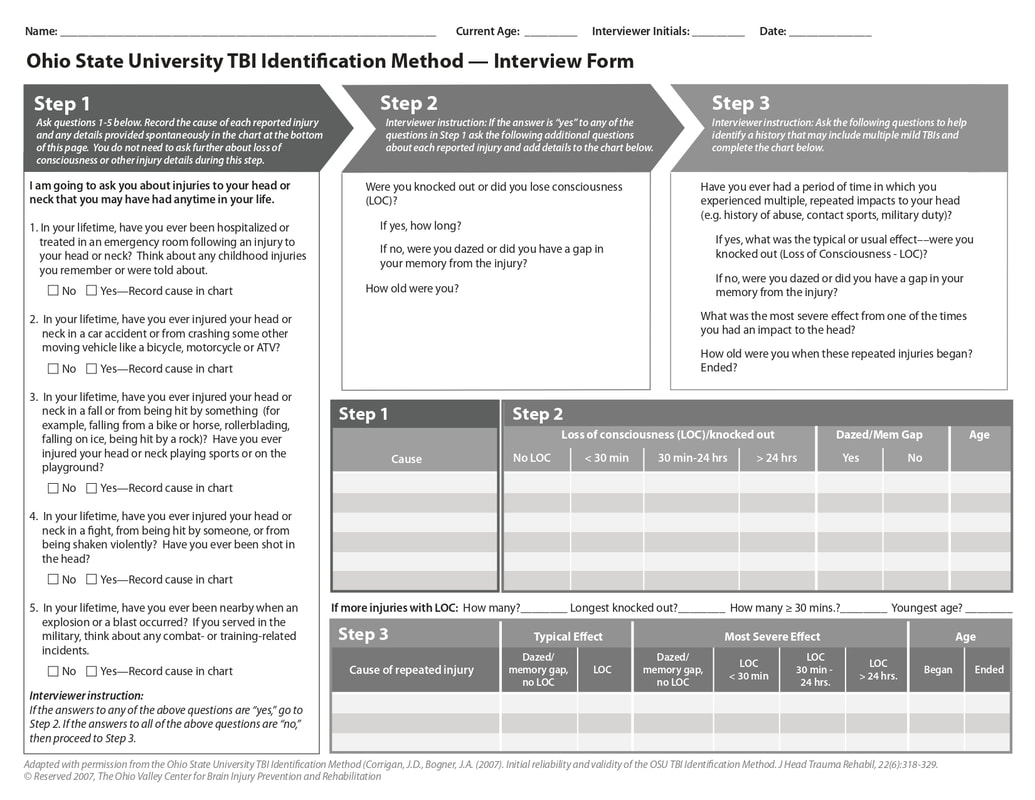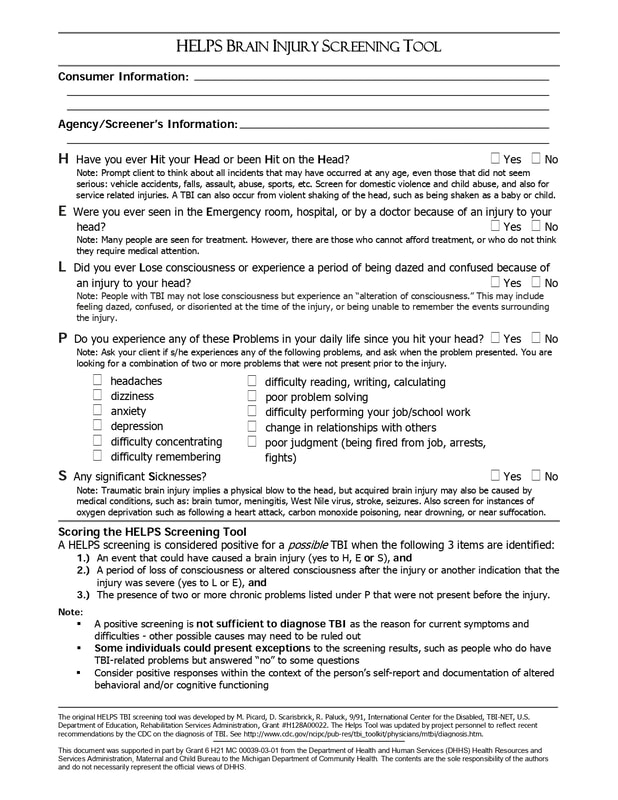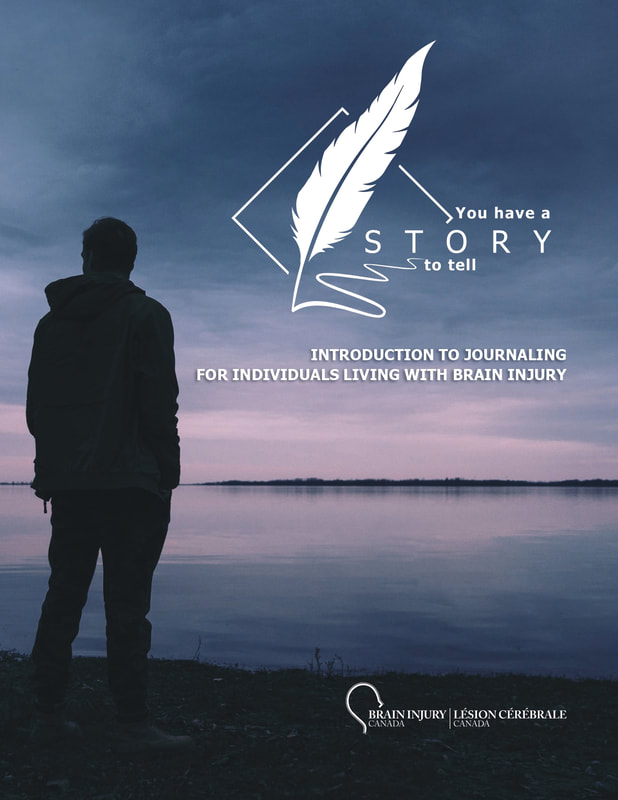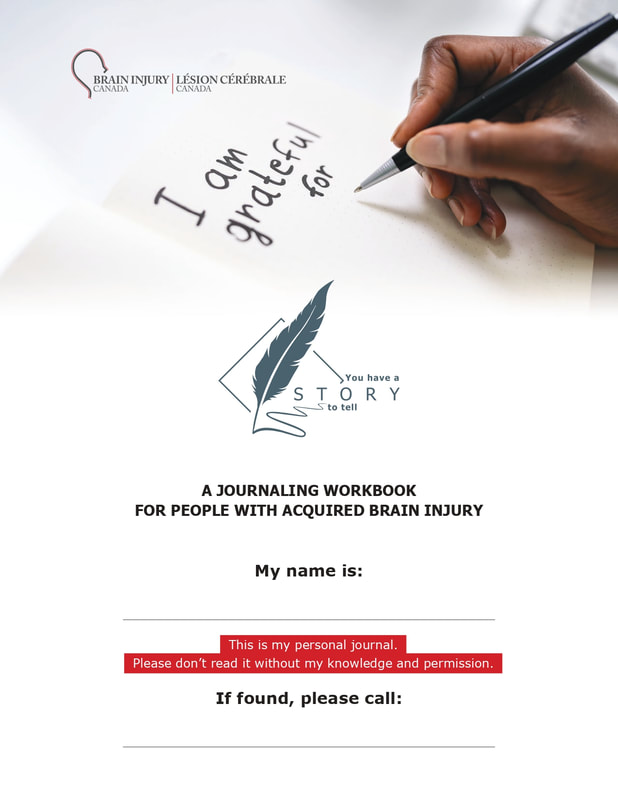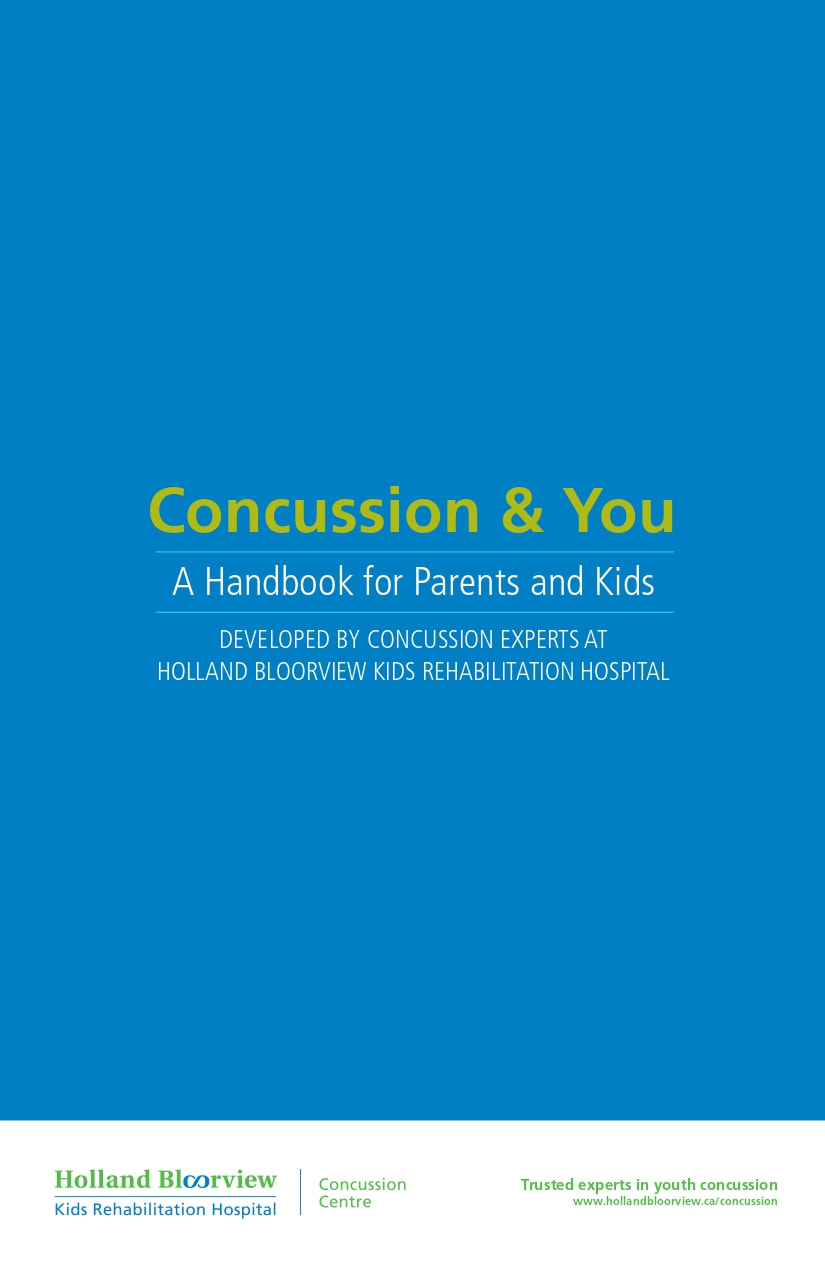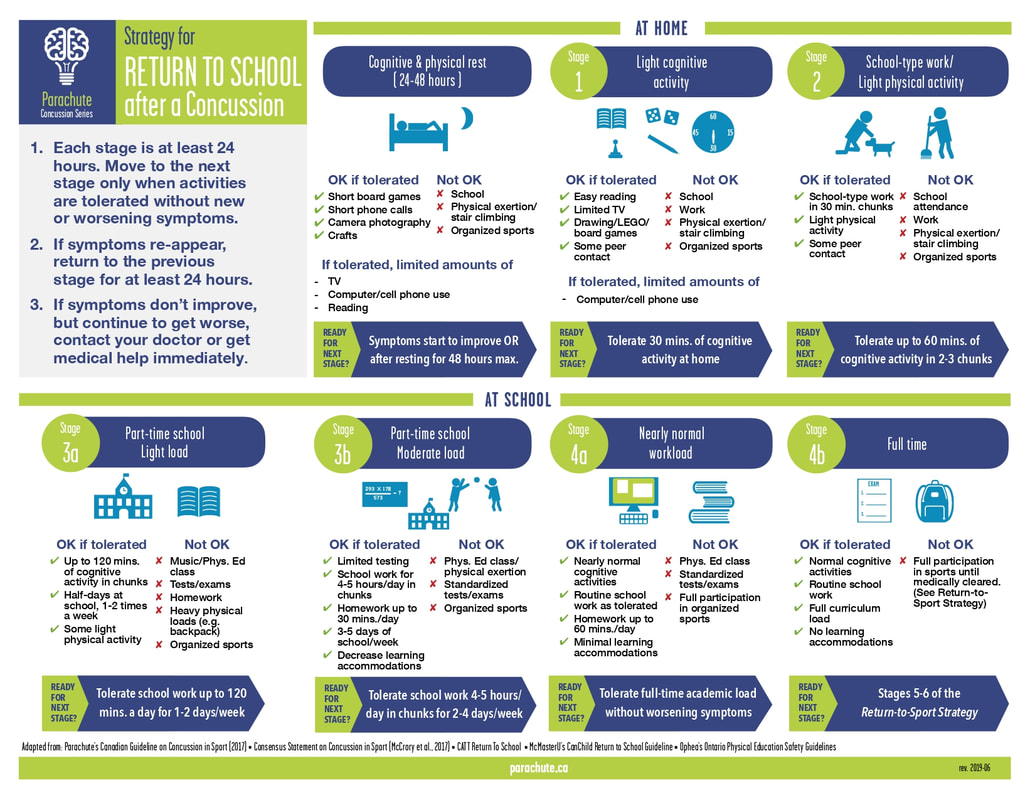Traumatic Brain Injury Screening Tools
These tools can be used to screen patients for a history of traumatic brain injury and start a conversation about TBI during clinical assessments.
Ohio State University. (2013). Ohio State University TBI Identification Method — Interview Form. Retrieved from https://wexnermedical.osu.edu/-/media/files/wexnermedical/patient-care/healthcare-services/neurological-institute/neuroscience-research-institute/osu_tbiform_july2013-final.pdf?rev=d11ca42cb8fd47169c558a603f0677c7&hash=D7E97209240357990CF1E157155FD46D
For information about this screening tool and how to use it: https://wexnermedical.osu.edu/neurological-institute/neuroscience-research-institute/research-centers/ohio-valley-center-for-brain-injury-prevention-and-rehabilitation/osu-tbi-id
For information about this screening tool and how to use it: https://wexnermedical.osu.edu/neurological-institute/neuroscience-research-institute/research-centers/ohio-valley-center-for-brain-injury-prevention-and-rehabilitation/osu-tbi-id
| ohio_state_university_tbi_identification_method-_interview_form.pdf | |
| File Size: | 65 kb |
| File Type: | |
Picard, M., Scarisbrick, D., Paluck, R. (1991). HELPS Brain Injury Screening Tool. Retrieved from https://abitoolkit.ca/assets/images/HELPS-tool.pdf
| helps_brain_injury_screening_tool.pdf | |
| File Size: | 49 kb |
| File Type: | |
Key Resource: Living Guideline for Pediatric Concussion Care
The Living Guideline for Pediatric Concussion care is a regularly updated guideline based on up-to-date evidence with clinical recommendations for health professionals managing children and adolescents with concussion. Links out to many tools, resources, and algorithms for concussion care, including management of persistent symptoms (see Section B). https://pedsconcussion.com/#
Other Resources and Toolkits
Downloadable guidebook by Brain Injury Canada which includes an introduction to journaling for mental health after a brain injury as well as a workbook which includes prompts and journaling activities (not youth-specific).
Brain Injury Canada. (n.d.). Journaling Workbook. Retrieved from https://braininjurycanada.ca/en/mental-health/journaling/workbooks/
Brain Injury Canada. (n.d.). Journaling Workbook. Retrieved from https://braininjurycanada.ca/en/mental-health/journaling/workbooks/
| abi-journaling-introduction-final.pdf | |
| File Size: | 1221 kb |
| File Type: | |
| abi-journaling-workbook-final.pdf | |
| File Size: | 1224 kb |
| File Type: | |
The Concussion Awareness Training Tool includes educational modules for health professionals on concussion/TBI recognition, diagnosis, treatment, and management. https://cattonline.com/
The Holland Bloorview Concussion Handbook is directed at youth and parents. This handbook helps with highlighting concussion/TBI symptom management strategies. This includes a self-management workbook that youth can use to make a plan for managing their recovery.
Holland Bloorview. (n.d.). Concussion and You- A Handbook for Parents and Kids. Retrieved from https://hollandbloorview.ca/concussion-handbook
Holland Bloorview. (n.d.). Concussion and You- A Handbook for Parents and Kids. Retrieved from https://hollandbloorview.ca/concussion-handbook
| concussion_handbook_march_2017_-no_crops.pdf | |
| File Size: | 7054 kb |
| File Type: | |
Parachute Canada Return-To-School Strategy provides staging for return to school post-concussion/TBI. This can be used to provide guidance for youth who need support with a full return to school activities.
Parachute Canada. (2017). Return to School Strategy. Retrieved from https://www.parachutecanada.org/wp-content/uploads/2019/06/Return-to-School-Strategy.pdf
Parachute Canada. (2017). Return to School Strategy. Retrieved from https://www.parachutecanada.org/wp-content/uploads/2019/06/Return-to-School-Strategy.pdf
| parachute_canada-_return_to_school_strategy.pdf | |
| File Size: | 765 kb |
| File Type: | |
Traumatic Brain Injury and Substance Use Disorders: Making the Connections: This toolkit, while not youth-focused, highlights important considerations for substance use treatment when working with individuals with traumatic brain injury.
Lemsky, C. (2021). Traumatic Brain Injury and Substance Use Disorders: Making the Connections. Retrieved from https://attcnetwork.org/sites/default/files/2021-11/TBI%20%20SUD%20Toolkit%20FINAL%2011.05.2021.pdf
Lemsky, C. (2021). Traumatic Brain Injury and Substance Use Disorders: Making the Connections. Retrieved from https://attcnetwork.org/sites/default/files/2021-11/TBI%20%20SUD%20Toolkit%20FINAL%2011.05.2021.pdf
| tbi__sud_toolkit_final_11.05.2021.pdf | |
| File Size: | 6401 kb |
| File Type: | |
Vancouver Coastal Health Concussion Guide (Teen Edition): For youth to learn about concussion/TBI symptoms and recovery. Includes a self-management tool which allows youth to build their own customized recovery plan https://teenconcussion.vch.ca/
Some considerations when working with youth who are recovering from or living with a TBI:
1) Discuss expectations for recovery with youth
2) Provide guidance for return to school and regular activities for youth with recent concussion
a. Importance of early return to school for well-being
b. Follow stages for slowly ramping up level of participation
c. See Parachute Canada return-to-school strategy or Living Guidelines for Pediatric Concussion protocols
3) Medication considerations
a. General principles include: starting with low dose and titrating slowly, with very close monitoring for adverse effects;
changing one medication at a time; be aware of potentially lowered seizure thresholds
4) Sleep
a. Review sleep hygiene interventions
b. Make a plan for getting in activity and light during the day in a way that won’t exacerbate concussion symptoms
5) Energy conservation
a. Consider using 4 P’s framework to help youth develop a plan for managing their energy and fatigue: Prioritize, Pace, Plan, Position
6) Adapting interventions for cognitive symptoms
a. Use of visual tools and concrete examples when reviewing or practising self-management skills
b. More frequent reminders of appointments and prompts for completing any exercises between sessions
c. Consider shorter sessions
d.Regular review/repetition during sessions
7) Consider journaling strategies
a. Can be useful for recording experiences and thoughts/feelings to discuss at appointments so they are not forgotten
b. Use for visual aids and recording experiences with practising self-management skills
c. See Brain Injury Canada journaling toolkit
8) Revisit conversations around substance use frequently
a. Substance use can increase after a TBI
b. Youth may be more sensitive and have lower tolerance for substances during recovery from their TBI
2) Provide guidance for return to school and regular activities for youth with recent concussion
a. Importance of early return to school for well-being
b. Follow stages for slowly ramping up level of participation
c. See Parachute Canada return-to-school strategy or Living Guidelines for Pediatric Concussion protocols
3) Medication considerations
a. General principles include: starting with low dose and titrating slowly, with very close monitoring for adverse effects;
changing one medication at a time; be aware of potentially lowered seizure thresholds
4) Sleep
a. Review sleep hygiene interventions
b. Make a plan for getting in activity and light during the day in a way that won’t exacerbate concussion symptoms
5) Energy conservation
a. Consider using 4 P’s framework to help youth develop a plan for managing their energy and fatigue: Prioritize, Pace, Plan, Position
6) Adapting interventions for cognitive symptoms
a. Use of visual tools and concrete examples when reviewing or practising self-management skills
b. More frequent reminders of appointments and prompts for completing any exercises between sessions
c. Consider shorter sessions
d.Regular review/repetition during sessions
7) Consider journaling strategies
a. Can be useful for recording experiences and thoughts/feelings to discuss at appointments so they are not forgotten
b. Use for visual aids and recording experiences with practising self-management skills
c. See Brain Injury Canada journaling toolkit
8) Revisit conversations around substance use frequently
a. Substance use can increase after a TBI
b. Youth may be more sensitive and have lower tolerance for substances during recovery from their TBI
